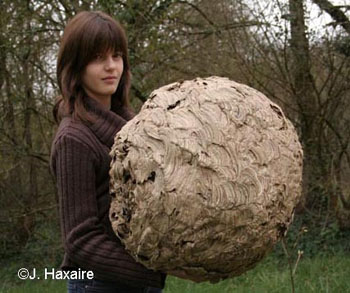 |
| Megashark attacking the Golden Gate Bridge. |
Well, the piece tells the story of workmen in Fife who have reported seeing a creature 'two to three inches long' buzzing around them. Understandably, confronted by this beast, one of the workmen dealt with it using the sophisticated piece of insect removal equipment known as a 'hammer'.
 |
| Just your standard piece of apparatus for insect annihilation... |
However, Asian Hornets are only 3cm in size, which is considerably smaller than the dimensions of the bothersome buzzer reported by the Fife workmen.
Given this dimension disparity, and the fact that there have been no cases of Asian Hornets in the UK, it is believed that the workmen actually saw the larger Vespa Crabro, more commonly known as the European Hornet or Horntail.
 |
| Queens of Vespa Crabro (right) and the smaller Vespa velutina (left). Source (Monceau et al., 2014) |
Originally from China, the Asian Hornet was accidentally introduced to France in 2004. Since then it has caused the deaths of six people. The population of Asian Hornets has grown rapidly and spread to other European countries including Spain, Portugal and Belgium (Monceau et al., 2014).
| Map highlighting the spread of the Asian Hornet from 2004-2010. |
With honeybees already facing a multitude of stresses, the introduction of this invasive to the UK would represent an unwelcome exacerbating factor. So what can be done?
 |
| Hello hornet, bye bye bees? |
Established Hornet's nests are costly and risky to destroy, with the process only deemed a success if every individual is destroyed (Monceau et al., 2014), which itself is hard to actually prove.
 |
| A sizable Asian Hornet nest. |
Clearly, the Asian Hornet could have a significant detrimental impact on Britain's apiculture. If you think you see one, maybe follow the example from the Fife workmen, grab your nearest hammer and go to town. However, also make sure you report it to the Non Native Species Secretariat!
Over and out
The Invader Inspector